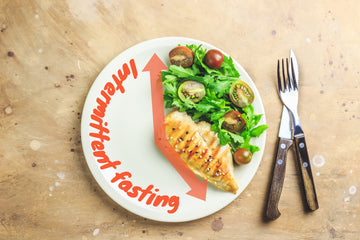

How the Low FODMAP Diet Is Good for Gut Health
The low FODMAP diet was designed to help people with irritable bowel syndrome (IBS) or small intestinal bacterial overgrowth (SIBO) discover which foods are causing digestive distress.
Many bariatric patients experience symptoms of IBS prior to bariatric surgery. However, more disturbingly, the incidence of SIBO following bariatric surgery is alarmingly high, with reports ranging from 43% to 77%. Therefore, many bariatric patients may speak with their healthcare team about following a low FODMAP diet, a temporary eating plan that limits certain carbohydrates in order to relieve uncomfortable symptoms for the long term.
It can be a challenging diet to follow, which makes working with a doctor or dietitian essential. They can ensure you’re following the diet correctly and maintaining proper nutrition, which is extremely critical when combining bariatric surgery with other GI conditions.
Why are FODMAPs Difficult to Digest?
FODMAP is an acronym for fermentable oligosaccharides, disaccharides, monosaccharides, and polyols. These are short-chain carbohydrates (sugars) that the small intestine cannot absorb. Your small intestine draws in water to move FODMAPs to the large intestine, where bacteria in your colon ferment (eat) them, which produces gasses and fatty acids as byproducts inside your gut.
For people with sensitive guts, the byproducts of fermentation may cause cramping, diarrhea, constipation, bloating, gas, and flatulence.
How Does the Low FODMAP Diet Work?
In 2005, researchers in the Department of Gastroenterology at Monash University in Melbourne, Australia, were the first to propose a low FODMAP diet. Following this diet consists of three phases.
- Substitution Phase – First, high FODMAP foods are swapped for low FODMAP alternatives for 2 to 6 weeks. While some refer to this as the elimination phase, Monash emphasizes it's about substituting foods instead.
- Reintroduction Phase – Next, while under the guidance of a registered dietitian, high FODMAP foods are reintroduced one at a time to identify which foods may be troublesome. This phase lasts around 6 to 8 weeks.
- Personalization Phase – Then, once you identify the foods that cause your symptoms, it is a whole lot easier to avoid or limit them. This is also known as the maintenance phase. By avoiding or limiting foods that aren’t tolerated well you may experience a lot of relief when it comes to those non-specific gastrointestinal symptoms.
What Are High FODMAP Foods to Avoid?
If you are wanting to try the FODMAP eating plan to ease GI symptoms, discuss risk versus benefit with your healthcare team. Then, once you move forward, you may choose to avoid high FODMAP foods that aggravate the gut, including:
- Vegetables – artichoke, asparagus, cauliflower, garlic, green peas, mushrooms, onion, and sugar snap peas.
- Fruits – apples, apple juice, cherries, dried fruit, mango, nectarines, peaches, pears, plums, and watermelon.
- Dairy and alternatives – cow’s milk, custard, evaporated milk, ice cream, soy milk (made from whole soybeans), sweetened condensed milk, and yogurt.
- Protein sources – some legumes, some marinated meats/poultry/seafood, and some professed meats.
- Bread and cereals – wheat/rye/barley-based bread, breakfast cereals, biscuits, and snack products.
- Sugars and sweeteners – high fructose corn syrup, honey, and sugar-free confectionery.
- Nuts and seeds – cashews and pistachios.
What Are Low FODMAP Foods?
Substitute high FODMAP foods for low FODMAP foods and build your meals around foods that may lower GI symptoms, which include:
- Vegetables – eggplant, green beans, bok choy, bell pepper, carrots, carrot, cucumber, lettuce, potato, tomato, and zucchini.
- Fruits – cantaloupe, kiwi, mandarin, orange, pineapple, and strawberries.
- Dairy and alternatives – almond milk, brie/camembert cheese, feta cheese, hard cheeses, lactose-free milk, and soy milk (made from soy protein).
- Protein sources – eggs, firm tofu, plain cooked meats/poultry/seafood, and tempeh.
- Bread and cereals – corn flakes, oats, plain rice cakes, spelt sourdough bread, and wheat/rye/barley-free bread.
- Sugars and sweeteners – dark chocolate, maple syrup, rice malt syrup, and table sugar.
- Nuts and seeds – macadamias, peanuts, pumpkin seeds, and walnuts.
Can a Low FODMAP Diet Help With Weight Loss?
While a low FODMAP diet may result in some weight loss initially, it is intended to alleviate digestive issues rather than serve as a weight loss plan. Any reduction in weight is often due to decreased calorie intake.
If you're looking to lose weight, consult your healthcare professional. They will provide more effective options and help determine the best choice for your health needs.
Depending on your current state of health, bariatric surgery may be evaluated by comparing risk versus benefit to determine if this is an option for you if you are someone impacted by obesity or overweight. This type of medical procedure is designed to help those impacted by obesity or overweight improve their health and lower the risk of serious weight-related conditions such as certain cancers, heart disease, high blood pressure, high cholesterol, type 2 diabetes, and others.
Choosing the right bariatric surgery for you and long-term follow-up are critical for overall health and wellness. And, if you've already had bariatric surgery, your medical professional can help you learn how to improve your gastrointestinal quality of life after surgery.
Types of bariatric surgery include the following.
- Gastric sleeve surgery induces weight loss by reducing the size of the stomach, providing restriction while also impacting hunger hormones, which aids in satiety (the feeling of fullness).
- Gastric bypass surgery reduces the size of the stomach and length of the small intestine, providing some malabsorption and restriction while also impacting hunger hormones, which aids in satiety.
- Adjustable gastric band surgery involves surgically implanting an adjustable gastric band, which restricts the amount of food that can be consumed and aids in achieving satiety without permanently cutting the intestines or stomach like other surgeries.
- Duodenal switch and SADI-S surgeries start with a gastric sleeve. A duodenal switch has two connections between the stomach and small intestine, whereas the SADI-S procedure has one. The duodenal switch removes more small intestine than any other procedure, providing the most malabsorption and likely the biggest impact on the hunger hormones. Meanwhile, the SADI-S procedure removes more small intestines than the gastric bypass. Both procedures provide restriction and malabsorption while impacting hunger hormones, which all aid in satiety.
Get the Essential Vitamins and Nutrients Your Body Needs
In order to optimize your health, it is critical to ensure proper supplementation. This is extremely critical for post-op bariatric patients who are also suffering from SIBO or IBS. Patients with SIBO are at an increased risk for nutrient deficiencies in addition to the risk that already exists from bariatric surgery.
ProCare Health is committed to bringing bariatric patients the best supplements on the market. Our products, developed by bariatric doctors and dietitians, allow you to provide your body with the vitamins and minerals it needs.
Supplements available include our:
- Once Daily Bariatric Multivitamin | Capsule
- Once Daily Bariatric Multivitamin | Chewable
- Once Daily Bariatric Multivitamin Capsule | DS / SADI
- Bariatric Multivitamin Capsule | Prenatal
- Bariatric Multivitamin Capsule | Probiotics
- and more!
We are here to help you reach your health goals as safely and efficiently as possible. To talk with a member of our team and learn more, contact us today!
Please see our terms and conditions for full medical disclaimer and usage of this information.









